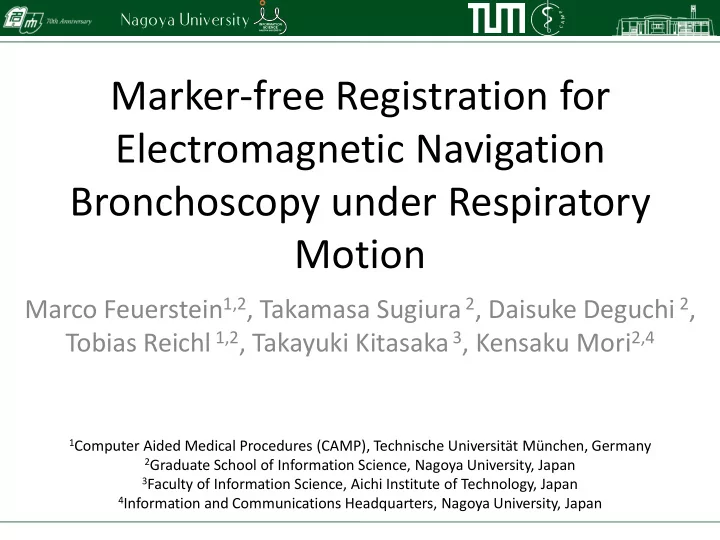

Nagoya University Marker-free Registration for Electromagnetic Navigation Bronchoscopy under Respiratory Motion Marco Feuerstein 1,2 , Takamasa Sugiura 2 , Daisuke Deguchi 2 , Tobias Reichl 1,2 , Takayuki Kitasaka 3 , Kensaku Mori 2,4 1 Computer Aided Medical Procedures (CAMP), Technische Universität München, Germany 2 Graduate School of Information Science, Nagoya University, Japan 3 Faculty of Information Science, Aichi Institute of Technology, Japan 4 Information and Communications Headquarters, Nagoya University, Japan
Nagoya University Introduction • Electromagnetic navigation bronchoscopy requires tracking of the camera and/or biopsy needles • Image-to-physical registration is difficult, because – CT image for navigation is static, but patient is breathing – Required corresponding points/features should be identified fast 9/20/2010 Marco Feuerstein, Computer Aided Medical Procedures, Technische Universit ä t M ü nchen 2
Nagoya University State of the Art • Marker-based registration – superDimension Not considering respiratory motion – Particle filtering [Gergel SPIE 2010] – Kalman filtering [Soper TBE 2010] Respiratory motion Initial registration manual and time-consuming • Marker-free registration [Deguchi SPIE 2007, Klein MICCAI 2007, Mori MICCAI 2008] Automatic rigid registration Respiratory motion handling insufficient 9/20/2010 Marco Feuerstein, Computer Aided Medical Procedures, Technische Universit ä t M ü nchen 3
Nagoya University Method: Respiratory Phase Detection • Attachment of cutaneous sensor to patient’s chest • PCA on sensor data • Projection of data onto principal motion axis 1 and normalization to s obtain surrogate data s 0 t • Attachment of second sensor to bronchoscope 9/20/2010 Marco Feuerstein, Computer Aided Medical Procedures, Technische Universit ä t M ü nchen 4
Nagoya University Method: Rigid registration • 2 rigid registrations on 1 upper and lower 10% of s data to determine, whether CT was acquired in 0 expiration or inspiration t • Minimization of squared distances of all bronchoscope sensor points from airways medial axis, normalized by branch radius to obtain initial transformation CT T EMT • Depending on minimization CT: Computed tomography coordinate system EMT: Electromagnetic tracking coordinate system result, CT phase p CT is 1 or 0 p k : bronchoscope sensor point r k : radius of corresponding bronchial branch d : Euclidean distance to medial axis 9/20/2010 Marco Feuerstein, Computer Aided Medical Procedures, Technische Universit ä t M ü nchen 5
Nagoya University Method: Respiratory Motion Correction • Second minimization to determine additional translation t cor that is scaled linearly with the respiratory phase measured by the surrogate sensor I p s p t 1 2 CT k cor CT Err t d T p cor EMT k T r 0 1 p P k k 1 s 0 t 9/20/2010 Marco Feuerstein, Computer Aided Medical Procedures, Technische Universit ä t M ü nchen 6
Nagoya University In Silico Evaluation • POPI model [Vandemeulebroucke ICCR 2007] – 10 respiratory phases – 12 breaths/min • Simulation of 10 different bronchoscope paths – Bronchoscope speed 10 mm/s – Added noise to simulate EMT jitter – EMT sampling rate 40 Hz • Error measurement using 37 landmarks selected by medical experts 9/20/2010 Marco Feuerstein, Computer Aided Medical Procedures, Technische Universit ä t M ü nchen 7
Nagoya University Registration Result Noise [Mori MICCAI 2008] Our new method w/o 3.4 ± 1.8 mm 2.4 ± 1.4 mm w 3.5 ± 1.8 mm 2.8 ± 1.6 mm 9/20/2010 Marco Feuerstein, Computer Aided Medical Procedures, Technische Universit ä t M ü nchen 8
Nagoya University 9/20/2010 Marco Feuerstein, Computer Aided Medical Procedures, Technische Universit ä t M ü nchen 9
Nagoya University Summary • Realistic respiratory motion simulation using real patient data • Improvement of state-of-the-art methods ご 清 [Deguchi SPIE 2007, Klein MICCAI 2007, Mori Thank you for your attention! 聴 あ MICCAI 2008] for marker-free registration り が – Inclusion of real distance from medial axis into と う error term ご ざ – Incorporation of respiratory motion い ま し た 。 9/20/2010 Marco Feuerstein, Computer Aided Medical Procedures, Technische Universit ä t M ü nchen 10
Recommend
More recommend